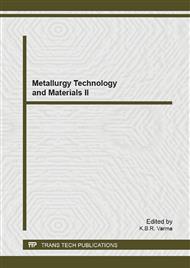[1]
H.M. Zeng, Q. Yu, et al., The Microstructure of CF and Its Composites, ZONG Shan University Press, Guang Zhou, (1990).
Google Scholar
[2]
X.Y. Wang, Tang Yuzhang, The Mechanical Properties of Composites, National Defense Technology University Press, Changsha, 1988, pp.12-13.
Google Scholar
[3]
E. Fitzer, The Future of Carbon-Carbon Composites, Carbon, 25 (1987) 163.
Google Scholar
[4]
Ariane, SPM upgrade, AIAA, 2004, p.3894.
Google Scholar
[5]
A. Heshmat, The effect of intermediate graphitization on the mechanical and fracture behavior of 2D C/C composites, Carbon, 31 (1993) 1121-1129.
DOI: 10.1016/0008-6223(93)90065-i
Google Scholar
[6]
J. Rahul, Modification of carbon-carbon composites with carbon nanofibers, Carbon (2005).
Google Scholar
[7]
E. Fitzer, Carbon based composites, Journal de chimie physique, 81(1984) 33-717.
Google Scholar
[8]
E. Fitzer, The future of carbon-carbon composites, Carbon, 25 (1987) 163-90.
Google Scholar
[9]
G. Savage, Carbon-carbon composites, Chapman & Hall, London, 1993, pp.59-323.
Google Scholar
[10]
G. Savage, Carbon-Carbon Composites, Chapman & Hall, London, 1993, pp.1-36.
Google Scholar
[11]
J.D. Buckley, Carbon-Carbon Materials and Composites, Noyes, NJ, 1993, pp.1-14.
Google Scholar
[12]
Z. Guo, J.X. Zhao, The Research and Development of C/C Composites, Space Navigation Materials Processing, 1995, pp.1-5.
Google Scholar
[13]
J.F. Huang, X.R. Zeng, H.J. Li et al, Oxidation Behavior of Sic-Al2O3-mullite Multi-coating coated Carbon/Carbon Composites at High Temperature, Carbon, 2005, pp.1557-1583.
DOI: 10.1016/j.carbon.2005.01.033
Google Scholar
[14]
J.W. Warren, Fiber and grain-reinforced chemical vapor infiltration (CVI) silicon carbide matrix composites, Ceram Eng Sci Proc, 1985, pp.684-693.
DOI: 10.1002/9780470320280.ch21
Google Scholar
[15]
Y.D. Zhang, X.J. Zhou, C.R. Zhang, The Development and Application Statement of C/SiC Ceramics Composites, Materials Engineering, 2005, p.60.
Google Scholar
[16]
K.K. Chawla, Composite Materials Science and Engineering, 2nd edition, Springer-Verlag, NY, 1998, pp.252-276.
Google Scholar
[17]
G. Savage, Carbon-Carbon Composites, Chapman & Hall, NY (1993).
Google Scholar
[18]
C.R. Thomas, ed., Essentials of Carbon-Carbon Composites, Royal Society of Chemistry, London (1993).
Google Scholar
[19]
E. Fitzer, The Future of Carbon-Carbon Composites, Carbon, 25 (1987) 163.
Google Scholar
[20]
N. Murdie, C.P. Ju, J. Don and M.A. Wright, Carbon-Carbon Matrix Materials, Carbon-Carbon Materials and Composites, 1993, p.197.
DOI: 10.1016/b978-0-8155-1324-7.50010-x
Google Scholar
[21]
Study on Preparation and Property of C/C Composite for Artificial Finger Joints, Tianjin University, Tianjin (2011).
Google Scholar
[22]
L.P. Ran, M.Z. Yi, et al, Influence of Adding Al on the Microstructure and Mechanical Properties of C/C-SiC Composites Fabricated by MSI, Acta Materiae Compositae Sinica, 2006, pp.34-38.
Google Scholar
[23]
W.C. Jenkins, Method of Depositing Metals and Metallic Compounds Thoughout the Pores of a Porous Body. U.S. Patent 3, 160, 157. (2001).
Google Scholar
[24]
R.M. Williams, Pyrolytically Reinforced Carbon Felt Composites, Pyrolytic Graphite Symposium, Palm Springs, CA (1966).
Google Scholar
[25]
L.P. Ran, M.Z. Yi, et al, Influence of Adding Al on the Microstructure and Mechanical Properties of C/C-SiC Composites Fabricated by MSI, Acta Materiae Compositae Sinica, 2006, pp.34-38.
Google Scholar
[26]
W.J. Lackey and T.L. Starr, Fabrication of Fiber-reinforced Ceramic Composites by Chemical Vapor Infiltration: Processing, Structure and Properties, Fiber Reinforced Ceramic Composites, 1991, p.397.
DOI: 10.1002/9780470320228.ch20
Google Scholar
[27]
W.V. Kotlensky, A Review of CVD Carbon Infiltration of Porous Substrate, Materials' 16th National SAMPE Sampe Symposium and Exhibit, 71 (1971) 257.
Google Scholar
[28]
B. Dacic and S. Marinkovic, Carbon-fiber-carbon Composites From Propylene by Chemical Vapor Deposition, High Temp. High Press, 1981, p.185.
Google Scholar
[29]
S. Marinkovic and Dimitrijevic, Carbon/carbon Composites Prepared by Chemical Vapor Deposition, Carbon, 1985, p.691.
Google Scholar
[30]
P. McAllister, E.E. Wolff, Modeling of Chemical Vapor Infiltration of Carbon Composites With Pyrolytic Carbon. Chem. Eng. Sci., 1990, p.2505.
DOI: 10.1016/0009-2509(90)80135-2
Google Scholar
[31]
Y.S. Lin, A.J. Burggraaf, Modelling and Analysis of CVD Process in Porous Media for Ceramic Composites Preparation, Carbon, 1991, p.3067.
Google Scholar
[32]
Y. Roman, Forced Flow Chemical Vapor Infiltration, TNO Institute of Applied Physics, Netherlands.
Google Scholar
[33]
K. Sugiyama, T. Nakamura, Pulse CVI of Porous Carbon, J. Mater. Sci. Lett., 1987, p.331.
Google Scholar
[34]
K. Sugiyama, U. Ohzawa, Consolidation of Si3N4 Powder Preform by Infiltration of BN using Pulse CVI Process, J. Mater. Sci. Lett., 1988, p.1221.
DOI: 10.1007/bf00722342
Google Scholar
[35]
K. Sugiyama, E. Yamamoto, Reinforcement and Antioxidizing of Porous Carbon by Pulse CVI of Sic. J. Mater. Sci., 1989, p.3756.
DOI: 10.1007/bf02385767
Google Scholar
[36]
K. Sugiyama and Y. Ohzawa, Pulse Chemical Vapor Infiltration of SiC in Porous Carbon and SiC Particulate Preform Using an R.F. Heating System, J. Mater. Sci., 1990, p.4511.
DOI: 10.1007/bf00581116
Google Scholar
[37]
J.Z. Zou, X.R. Zeng, X.B. Xiong, Microwave Assisted Chemical Vapor Infiltration to Prepare Carbon/Carbon Composites, New Carbon Materials, 2009, pp.136-140.
DOI: 10.1016/j.carbon.2009.06.009
Google Scholar
[38]
S.Z. Jiang, Z. Li, X. Xiong, et al, Preparation and Microstructure of C/C-SiC Composites Fabricated by Warm Compressed-in situ Reacted Process, Journal of Central South University (Science and Technology), 2011, pp.1588-1592.
Google Scholar
[39]
X. Xiong, W.M. Kuang, Xiao Peng, et al, Mechanical Properties of C/C Composites by Compression Molding, J. Cent. South Univ. (Science and Technology), 2008, pp.486-492.
Google Scholar
[40]
H.T. Wu, X. Wei et al, Ablation Performances of Multi-phased C/C-ZrC-SiC Ultra-high Temperature Composites, Journal of Inorganic Material, 2011, pp.852-856.
DOI: 10.3724/sp.j.1077.2011.00852
Google Scholar
[41]
X.C. Zuo, Preparation Method of C/C Composites Through One Step, Beijing Chemical Engineering, Beijing, 2006, p.41.
Google Scholar


